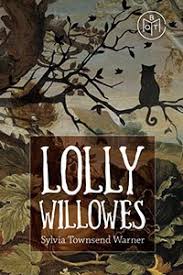 It’s England in the early 20th century; the Willowes, an upper-class family, live on their country estate, Lady Place. Laura Willowes, or Lolly as her family call her, is her father’s beloved youngest child and only daughter. Possessing a ‘temperamental indifference to the need of getting married’ she remains at home as his companion after he is widowed. But when he dies, she is whisked away to live with her brother Henry, sister-in-law Caroline and two nieces.
It’s England in the early 20th century; the Willowes, an upper-class family, live on their country estate, Lady Place. Laura Willowes, or Lolly as her family call her, is her father’s beloved youngest child and only daughter. Possessing a ‘temperamental indifference to the need of getting married’ she remains at home as his companion after he is widowed. But when he dies, she is whisked away to live with her brother Henry, sister-in-law Caroline and two nieces.
Lolly was a gentle creature, and the little girls loved her; she would soon fit into her new home… London would be a pleasant change for her. She would meet nice people, and in London she would have a better chance of marrying. Lolly was twenty-eight. She would have to make haste if she was going to find a husband before she was thirty. Poor Lolly! Black was not becoming to her. She looked sallow, and her pale grey eyes were paler and more surprising than ever underneath that very unbecoming black mushroom hat. Mourning was never satisfactory if one bought it in a country own.
Seemingly without any choice in the matter, she is moulded by Caroline and Henry into the typical Edwardian maiden aunt. Time passes. The girls grow up. When WWI intervenes, she volunteers but there is no drama or excitement for Lolly – ‘Four times a week she went to a depot and did up parcels. She did them up so well that no one thought of offering her a change of work’. After the war, her stifled, restricted way of life continues. Somehow she retains a sliver of vivid individuality, symbolised by her ‘extravagant’ (according to her sister-in-law) habit of buying huge bunches of cut flowers for her little room. It is these flowers that lead her to a momentous decision. In a greengrocer-cum-florist, she sees a bunch of chrysanthemums which change her life.
She looked at the large mop-headed chrysanthemums. Their curled petals were a deep garnet colour within and tawny yellow without. As the light fell on their sleek flesh, the garnet colour glowed, the tawny yellow paled as if washed with silver. She longed for the moment when she might stroke her hand over their mop heads.
‘I think I will take them all,’ she said.
‘They’re lovely blooms,’ said the man.
He was pleased. He did not expect such a good customer at this late hour.
When he brought her the change from her pound note and the chrysanthemums pinned up in sheets of white paper, he brought also several sprays of beech leaves. These, he explained, were thrown in with the purchase. Laura took them in her arms. The great fans of orange tracery seemed even more beautiful to her than the chrysanthemums, for they had been given to her, they were a surprise. She sniffed. They smelt of woods, of dark rustling woods like the wood to whose edge she came so often in the country of her autumn imagination. She stood very still to make quite sure of her sensations. Then: ‘Where do they come from?’
And that is how Lolly decides to reject her family and her conventional role in it, her brother’s patriarchal control of her (and her money) and London life to go to live in the village of Great Mop. But no spoiler here, except to say that the satirical social novel of the earlier chapters takes a sharp turn, or rather, twist.
 It’s always a treat to discover a new book by a new writer. And Lolly Willowes is delicious. Sly, subversive, it seems to be about one thing – the liberation of an English spinster – and then it turns out to tell a different story altogether. When it was published in 1926, Lolly Willowes was popular in the UK, France and even in the US where it was the very first Book of the Month Club selection. The author wrote a handful of other novels, poetry, and short stories which were published in the New Yorker. She’s a marvellous writer. Yet she seems to be mostly forgotten today.
It’s always a treat to discover a new book by a new writer. And Lolly Willowes is delicious. Sly, subversive, it seems to be about one thing – the liberation of an English spinster – and then it turns out to tell a different story altogether. When it was published in 1926, Lolly Willowes was popular in the UK, France and even in the US where it was the very first Book of the Month Club selection. The author wrote a handful of other novels, poetry, and short stories which were published in the New Yorker. She’s a marvellous writer. Yet she seems to be mostly forgotten today.

I have heard of this book! But you make it sound even more enticing. It sounds right up my alley.
Kate, I think you would love it. I read it on my Kindle, but have just bought a beautiful little cloth-bound hardcover Penguin Classics edition at Bookish in Bendigo because it’s one I will read again.